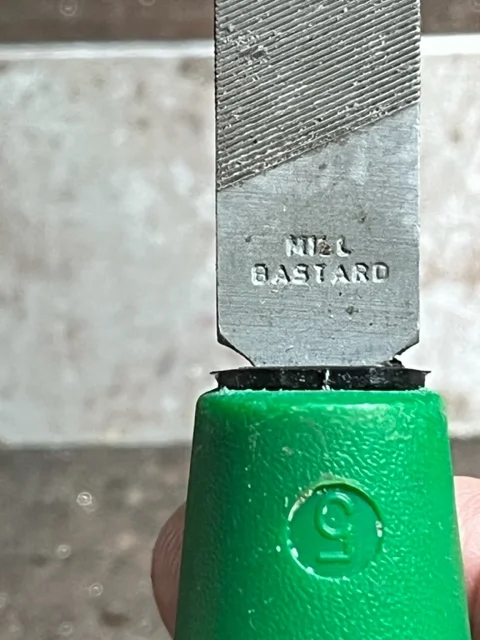Files can be a wonderful tool on your jewellery bench or a prized possession. On my setting bench they are a tool that can be bought even at your local hardware stores.
The first file (on top) is used primarily for wax filing. These well spaced teeth are not to be misconstrued in filing or trimming of metal. Their (teeth) sole purpose is to remove large amounts of wax that will be used prior to the metal filing process.
The lower file picture is used in the removal of unwanted metal.
As a few of these files look almost the same at a distance, I 'number' each of them. Why would I need a "O" then pick up a "1" instead? A few problems would ensue.
The two "OO" signifies a grit #2. I used this as there wasn't too much space to write exact number.
This has dual purposes, on one side it is flat and the other side being shown has a curved surface. This 'rough textured' file is used mainly for wax carving.
You can easily see just how wide the teeth are, these teeth won't file smooth, but used to remove unwanted wax from a new design.
I paint numbers on files just to distinguish one grit from the other. (Excuse the rust spots)
This file has a grit number of "O", it is used to remove any 'rough casting' defects.
These are photos taken with my Digital Microscope at 240x power magnification. These files are used often as you can see remnants of particles from prior cleaning.
"WAX-SHAPING FILES"
These wax removing files only do one thing and that is to shape the new wax form. These 'sharp teeth' literally grab the not-needed wax and assist in shaping the wax form.
For your eyes, this file has two surfaces, one side is FLAT and the other is SEMI-ROUND.
BTW, I remove the wax by applying a low heat torch to the teeth and the wax just melts or burns away.
A less aggressive file is a "Half-Round '0' grit" file, this will give a smoother 'finishing surface'.
=========================================
"BUYING FILES AT A HARDWARE STORE"
There is nothing to be ashamed about this 'alternate buying' venture. These files are much cheaper and the stores have a wide selection.
My favourite places are the "DOLLAR STORE and "HOME DEPOT". Most of my larger files came from these two (international) chain stores.
===========================
TRIANGULAR FILES"
(I'm using only a #4 grit file, as #2 is usually too aggressive for this kind of delicate filing.)
I've now finished with the large 'hand-held' files and now I'm going to now display the "Triangular" 8-inch files and their numerous setting applications.
These files are used primarily for detailed cleaning around gemstone setting and the tips of claws.
Instead of numbers everywhere, I use 'felt-ink line markings'. I can make these markings all around the handle, instead of searching the 'grit' when needed.
Here are a few examples where these Triangular files are to be used. Although these have been used in my recent essays, these are great for this particular tutorial-essay.
This delicate trimming was done with a #4 grit Triangular file, even at the outside curves.
All of these detail finishing were as an example of #4 grit filing. I rarely use a #2 grit file for this very delicate work.
This particular filing on the 'outside of the claws' takes MUCH PRACTICE.
I suggest that the 4 "ends" of the Bezel be trimmed first, then file ONLY with the #4 grit Triangular file.
Please be very attentive when trimming the "V" claws, this is a very delicate area. Again, #4 grit Triangular file is required at all times.
(I will use my Pumice wheels of #180 grit to remove any marks remaining on the delicate metal. This "Triangular" setting is not on my 'to explain & display list'.)
gerrylewy18@gmail.com
























No comments:
Post a Comment